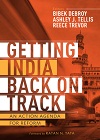India’s recently elected Prime Minister Narendra Modi has entered the political stage in what one may consider both the best and worst of times – the former because he has been given a thumping majority and a mandate for change unparalleled in India’s history. There is a “deep yearning for change” and India seems seized by “the imperative of returning the country to a path of high growth”.
At the same time, one would not be faulted for considering these the worst of times, at least in India’s recent history. The World Bank ranks India 134 in terms of ease of doing business; at the same time the nation needs to create 1 million new jobs each month for that is the number added by India’s demographics to the labor pool.
The book’s overriding message is unequivocal: “the most important priority for the new government is undoubtedly the revival of India’s economic growth”. This is accompanied by a dire warning “If New Delhi does not act quickly, it will be left out in the cold as trade liberalization gains traction in the Asia-Pacific and the Atlantic through the Trans-Pacific Partnership and Transatlantic Trade and Investment Partnership negotiations”.
Lenin once famously asked “What is to be done?” This book sets out a very comprehensive agenda for action; so thorough and detailed are the book’s prescriptions that the new government would do well to insist that its senior bureaucrats and cabinet members read and follow it diligently. The editors have chosen experts to write on the various subjects that the book covers – importantly, they are experts who live in India and have been a part of the economy or government for years. This last is important because suggestions, made in a vacuum, can fall on deaf ears. Recommendations made with the realisation of what is plausible in the Indian context have a far greater chance of success.
The book is a scathing attack on the socialist ideals much celebrated in India through the decades of the 50s, 60s, 70s and 80s. “Socialism has corrupted the deep structure of state-society relations in India”, Tellis writes in the introduction. “A slow rollback of socialist policies has been under way since 1991. But unlike the case in China since 1978, this shift in India has been hesitant, conflicted and furtive”.
The introductory chapter is a superb analysis of the accomplishments and pitfalls of the six decades after independence. On the one hand, the leadership’s commitment to a “combination of liberal democracy, civic nationalism, and socialist economics was essential to successfully building a modern Indian state.” The Indian constitution embraced ambitious aims “to create social, economic and political institutions which will ensure justice and fullness of life to every man and woman”. It is the adoption of state control on resources and the direction of the economy, the intense planning at the center as embodied in the Planning Commission that has proved to be the pitfall.
The scope of the book is wide; its seventeen chapters cover issues ranging from what ails the agriculture sector to how manufacturing can be revived; how to bring about macroeconomic stability and the folly of becoming a welfare state when the national budget is running into huge deficits. The important subjects of education, health, governance, and environmental issues, are given a thorough analysis; the final chapter deals with the rejuvenation of the country’s foreign policy. The book’s strength lies in its clarity; each chapter starts with a diagnostic analysis in the vein of “what went wrong” and concludes with a thoroughly detailed prescription.
The contributors to the book are daring in their suggestions and certainly do not mince words about what ails India. There is a clear analysis of the problem and the recommendations made are very much to the point. What remains to be seen, and, ay there’s the rub of it, is what the Modi government will have the courage to implement. India’s entrenched bureaucracy, not known for its ability to adapt, the systemic corruption in the country and the lingering vestiges of the socialist era will be hard to change. How far a government, even one which has made a commitment to reform, can go to shake up the almost sclerotic nature of the system remains to be seen.
The Modi government has been ushered in with high expectations. It is early days but in the four months since the election, no bold measures have been announced. The budget is tame and no forays have been made in the much needed areas of privatization, corporate tax reform, land acquisition laws, etc. all of which the book recommends. At the same time the decision to block the WTO negotiations has sent a message to the world that India has not budged from its legendary position as “spoiler”.
Getting India back on track: An Action Agenda for Reform, Editors: Bibek Debroy, Ashley J. Tellis and Reece Trevor, Random House India, June 2014
Meera Kumar is a New York-based public relations professional. She has worked with the Asian Development Bank, the State University of New York, New York University, and several Fortune 20 companies.
This review was exclusively written for Gateway House: Indian Council on Global Relations. You can read more exclusive content here.
For interview requests with the author, or for permission to republish, please contact outreach@gatewayhouse.in.
© Copyright 2014 Gateway House: Indian Council on Global Relations. All rights reserved. Any unauthorized copying or reproduction is strictly prohibited.


